Comprehensive Guide to Brass Water Faucets: Description

Introduction
Brass water faucets are crucial components in various water systems, serving to control water flow, adjust pressure, and direct the stream. Known for their durability and excellent mechanical properties, brass faucets are widely used in residential, commercial, and industrial settings. This article delves into the structure, materials, working principles, applications, and importance of brass faucets in fluid control, aiming to help users understand their functionality and optimize related content for search engine ranking (SEO).
Structure and Materials
1. Material Composition:
Brass faucets are primarily made from brass alloys containing 70% to 90% copper. This alloy is renowned for its excellent corrosion resistance and mechanical strength. Brass, consisting mainly of copper and zinc, offers high wear resistance and corrosion protection, making it suitable for various water quality conditions.
2. Design Structure:
Brass faucets typically include key components such as the valve body, handle, rotating parts, and sealing rings. The valve body is the core of the faucet, determining the control capability of the water flow. The handle is used to adjust the faucet’s on/off state and flow rate, while the rotating parts allow for changes in the water flow direction. Sealing rings ensure the faucet’s leak-proof performance under various working conditions.
Working Principles
1. On/Off Functionality:
Brass faucets operate by rotating the handle to control the water flow. When the handle is turned, the internal valve seat moves to open or close the water passage. The handle design ensures ease of operation and precise control.
2. Flow Rate Adjustment:
Beyond the basic on/off functionality, brass faucets can adjust the flow rate. By positioning the handle, users can modify the water flow volume to meet different needs.
3. Sealing Performance:
The design of sealing rings is crucial for preventing leaks. Brass faucets commonly use materials resistant to high temperatures and corrosion, such as Viton or PTFE, to enhance durability and reliability.
Application Areas
1. Residential Water Systems:
In residential settings, brass faucets are used in kitchen sinks, bathroom taps, and garden hoses. They provide stable water flow and effective flow rate adjustment, meeting daily household needs.
2. Industrial Applications:
In industrial environments, brass faucets are used in various water systems, including cooling systems, processing equipment, and cleaning devices. Their excellent corrosion resistance and strength make them reliable in harsh conditions.
3. Commercial Use:
In commercial spaces like restaurants, hotels, and large office buildings, brass faucets are used in various facilities to provide efficient and reliable water flow control, ensuring smooth operations.
Typical Application Cases
1. Kitchen Faucets:
In residential kitchens, brass faucets are an integral part of the sink setup, offering stable water flow and convenient adjustment features. Users can easily control water temperature and flow rate for cooking and cleaning purposes.
2. Industrial Cooling Systems:
In industrial cooling systems, brass faucets control the flow of coolant to maintain equipment at optimal temperatures. Their corrosion resistance and strength ensure long-term stable operation.
3. Garden Irrigation:
In garden irrigation systems, brass faucets regulate water flow to achieve precise watering. Their durability and adjustability make them essential tools for effective garden management.
Conclusion
Brass water faucets, with their excellent materials, structural design, and wide range of applications, are indispensable components in various water systems. By understanding the functions and applications of brass faucets,
